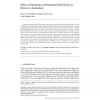Free Online Productivity Tools
i2Speak
i2Symbol
i2OCR
iTex2Img
iWeb2Print
iWeb2Shot
i2Type
iPdf2Split
iPdf2Merge
i2Bopomofo
i2Arabic
i2Style
i2Image
i2PDF
iLatex2Rtf
Sci2ools
APGV
2008
ACM
2008
ACM
Effect of scenario on perceptual sensitivity to errors in animation
simulations compare to similar measurements done in more abstract settings. We find that participant tolerance for certain types of errors is significantly higher in a realistic snooker than in the abstract test settings previously used to examine those errors. By contrast, we find tolerance for errors displayed in realistic but more neutral environments was not different erance for those errors in abstract settings. Additionally, we examine the interaction of auditory and visual cues in determining participant sensitivity to spatiotemporal errors in rigid body collisions. We find that participants are predominantly affected by visual cues. Finally, we find that tolerance for spatial gaps during collision events is constant for a wide range of viewing angles if the effect of foreshortening and occlusion caused by the viewing angle is taken into account. Categories and Subject Descriptors: I.3.7 [Computer Graphics]: Three-Dimensional Graphics and Realism-Animation General Terms: Experim...
| Added | 12 Oct 2010 |
| Updated | 12 Oct 2010 |
| Type | Conference |
| Year | 2008 |
| Where | APGV |
| Authors | Paul S. A. Reitsma, Carol O'Sullivan |
Comments (0)

